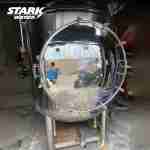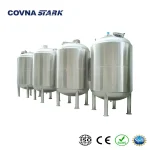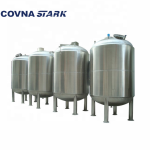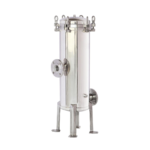Introduction: Why Water Storage Matters in the Pharmaceutical Industry
In the pharmaceutical industry, water is not just a utility—it’s a critical raw material. Whether it’s used for formulation, equipment rinsing, or final product processing, water quality and purity must meet stringent international standards. However, while much attention is given to purification systems like RO, EDI, or distillation, the storage tank that holds purified water is often overlooked.
A poorly designed or substandard tank can easily compromise the integrity of the entire water system. Bacterial growth, contamination from reactive materials, or stagnant zones due to improper tank geometry can all lead to failed validation or regulatory non-compliance. This is especially true in GMP-regulated environments where water must remain sterile, traceable, and consistent.
This article explores the critical requirements for pharmaceutical-grade water tanks and presents STARK’s hygienic tank solutions engineered to meet global compliance and operational excellence.
Key Requirements for Pharmaceutical Water Tanks
Water storage in pharmaceutical environments must adhere to strict hygienic, structural, and regulatory requirements. A pharmaceutical-grade tank is not just about holding purified water—it must preserve its quality until the point of use without introducing contamination, stagnation, or particulate matter.
Essential Design Criteria:
- Material: Only SUS316L stainless steel is acceptable for contact surfaces, due to its superior resistance to corrosion, chlorides, and sanitization chemicals.
- Surface Finish: Internal surfaces must be mirror-polished to Ra ≤ 0.4 μm or electropolished to prevent bacterial adhesion and biofilm formation.
- Bottom Geometry: Sloped or conical bottoms are required to ensure complete drainage and avoid dead zones.
- Sterile Breather Valve: Prevents airborne contamination while allowing pressure equalization.
- CIP/SIP Compatibility: Tank must include spray balls, ports, or nozzles for integration with Clean-In-Place and Sterilize-In-Place systems.
- Instrumentation: Level sensors, pressure gauges, temperature ports, and sampling valves for full monitoring and control.
- Regulatory Compliance: Design must support validation under GMP, FDA, USP, and 3-A standards.
Failure to meet any of these criteria can result in regulatory violations, batch rejection, or microbial contamination—leading to production downtime and quality risks.
STARK 316L Stainless Steel Tanks – Engineered for Pharma Use
At STARK, we specialize in the design and fabrication of pharmaceutical-grade stainless steel tanks that meet the highest global standards. Our tanks are built using certified SUS316L stainless steel and feature hygienic construction throughout—from orbital welding to mirror polishing to component selection.
Key Features:
- Volume range: 500L to 10,000L+, fully customizable
- Material: SUS316L with full traceability certificates (EN10204 3.1)
- Internal finish: Ra ≤ 0.4 μm (mechanical polish or electropolished)
- Welding: Automatic orbital TIG welding with full weld passivation
- Fittings: Tri-clamp ports, sterile breather valves, sampling valves, CIP/SIP spray balls
- Drainage: Conical/sloped bottom with zero dead-leg outlet
- Compliance: Supports GMP, FDA, USP, 3-A validation with documentation
Each tank can be supplied with technical drawings, 3D models, pressure test reports, and optional FAT protocols upon request.
🔗 Learn more or request a quote for our pharmaceutical tank series:
STARK 316L Stainless Steel Sterile Water Tank
Real-World Case Study: Pharmaceutical Manufacturer Achieves Compliance and Stability
A mid-sized pharmaceutical facility in the Middle East faced challenges with microbial contamination and non-compliance during a GMP audit. The company was using a 2000-liter plastic storage tank for purified water (PW), which lacked documentation, had dead zones at the bottom, and was difficult to clean. The result: recurring batch rejections and audit failures.
Upon evaluation, STARK engineers proposed a fully traceable SUS316L sterile tank with the following specifications:
- Capacity: 2000L
- Mirror-polished interior (Ra ≤ 0.4 μm)
- Tri-clamp CIP spray ball, sterile breather valve, sampling port
- Conical bottom with 100% drainability
- Supplied with 3.1 material certificates, weld map, and pressure test report
Results within 90 days of implementation:
- ✔ Passed GMP inspection with full tank validation support
- ✔ Microbial count reduced by >95%
- ✔ Integrated into CIP system, reducing manual cleaning time by 70%
- ✔ Production downtime due to water quality issues dropped to zero
This case highlights how upgrading to a certified stainless steel tank not only protects product integrity but also supports regulatory compliance, risk reduction, and process efficiency.
Conclusion: Choose Tanks that Meet Regulatory and Operational Standards
In the pharmaceutical industry, water storage is not an afterthought—it’s a validated, monitored, and often inspected component of your entire production line. Using the wrong tank material or design can lead to microbial contamination, failed audits, and significant operational downtime.
By choosing SUS316L stainless steel sterile tanks engineered for hygienic performance, you not only safeguard your product quality but also streamline validation processes and reduce long-term maintenance overhead. Whether you’re storing purified water (PW), water for injection (WFI), or ultra-pure water, STARK can help you meet the exacting demands of pharma-grade storage.
At STARK, we work closely with pharmaceutical manufacturers, engineering contractors, and validation teams to deliver tanks that meet both technical performance and regulatory compliance.
Looking for a tank that meets GMP, FDA, or USP standards?
Contact our engineering team today
for drawings, certification support, and a tailored quotation.





